Motorcycle Fuel Injection
Note: As of June 2018 these are no
longer being
shipped or manufactured by RB Racing. We did it for 26+ years
when
there was no efi. We are transitioning to high end Motorsport
systems in support of our Turbocharged EVO Engines.
Lots of records were set with these. Very few
people
actually know much about efi... In 26+ years we only dealt
with a
few people who used our software and hardware that did any
tuning at
all...Most simply took what we set up for them to set
records...Harleys, Suzukis, Kawasakis, Yamahas, Truimphs, BMWs,
Hondas.
Everyone wants answers, does not want to learn and expects free
help.
These days most serious racing involves high end
electronics, traction control, closed loop boost control, data
logging
and wiring harnesses that cost more than the electronics. This
involves
tens of thousands of dollars in hardware and support issues.
We did it for pennies on the dollar and gave free
support and tuning. OK to set records. Not a good business plan
however.
Time to move on.
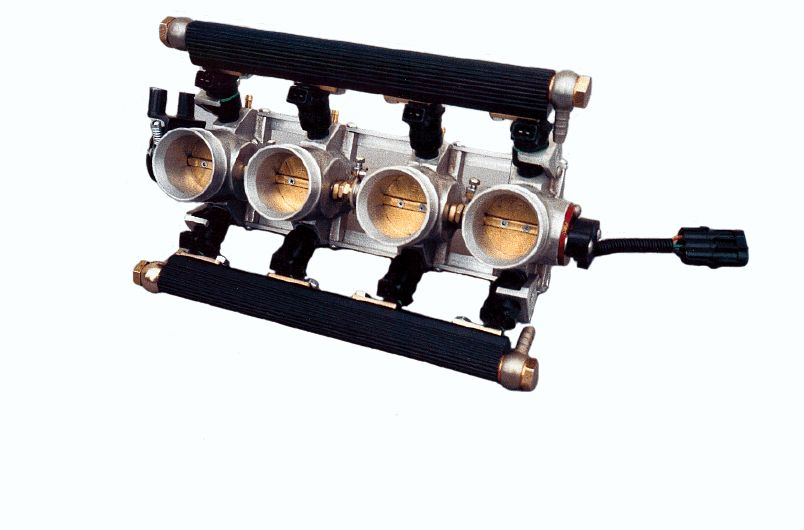
One two three four
RSR Fuel Injections are available for singles, twins, triples, v-fours, in-line fours, and can be adapted to almost any engine with anywhere from one, up to eight fuel injectors covering from next to nothing up to 500+ horsepower. RB Racing is the only firm that manufactures its own electronics, wiring harnesses and custom throttle bodies specifically for motorcycle engines. And most importantly we are the only firm that can offer Autocal, the software that writes the ecu calibrations for you.
No more brass jets
The basic engine functions you are most concerned with are completely covered by the RSR Electronic Control Unit (ECU) or "black box" if you will. Inputs from sensors provide accurate information on engine and air temperatures, manifold pressures, barometric pressure, exhaust gas content, throttle position, by-pass air, and of course engine speed, and update your fuel requirements hundreds of times per second. There is no need to fiddle with brass jets, jet kits, modify air boxes and the like. With a personal computer you can "talk" to your RSR ECU and optimize your fuel delivery for your particular combination of cams, compression, valve sizes and exhaust systems. If you change your motor you can update your ecu in minutes without having to dangle carbs off the side of the bike and draining float bowls to get at the jets. It's a different way of tuning but once you get the flow of it, you will never go back to carburetors.
Tuning RSR Fuel Injections
For a detailed discussion of Autocal Software and the RSR Air Fuel Ratio Gauge link to these appropriate sections. Suffice to say we provide you the software expertise and analytical tools to get your motor running and you on your way in short order. As we say, when you get up in the morning and look in the mirror, "there is the tuner". The RSR system remains the most user friendly efi system in the world. For a comparison of the RSR Fuel Injection versus other systems read our About RSR section.
Closed-Loop
Using a Bosch oxygen sensor your RSR ECU constantly monitors your exhaust gas content and maintains a stoichiometric fuel ratio of 14.7:1 i.e. 14.7 pounds of air to every pound of fuel consumed. This gives you excellent mileage and driveability. If you go to full throttle the system goes to "open loop" to allow a richer, more powerful fuel mixture, typically 13.2:1. For leaded racing fuels the system can be programmed to run open-loop only which means it runs on preprogrammed values and does not autocorrect except for input variables such as temperature or altitude changes.
RSR Throttle Bodies
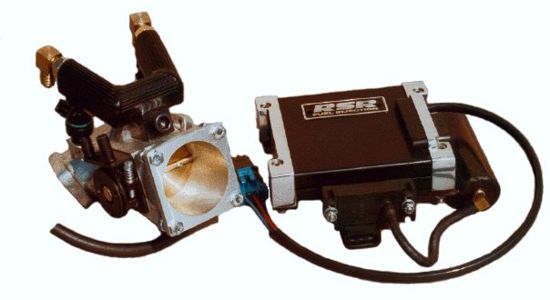
RB Racing's RSR Throttle Bodies are custom machined for each application so they will directly bolt in to your existing rubber spigots. The castings can be machined up to 50mm, but this is not possible for all applications as the spigots, inlet ports, or bore spacing will often limit the diameter of the bore...this is decided on a case to case basis. RSR Fuel Injections for Harley Davidsons use a single 2 3/16" (56mm) throttle body with a separate inlet manifold that has 2 to 4 injectors installed directly in the ports. Typical in-line fours are usually machined with 42mm throttle bores. Some cases like the Yamaha V-Max are taper bored with the actual exit measured at 38mm. Singles and twins are usually done at 45 to 50 mm. All throttle bodies feature individual butterfly synchronization, idle air by-pass ports, vacuum synchronization ports, throttle cable assembles, either single or dual fuel injectors per port, machined lip for specific K&N air filters, throttle position sensor boss, and idle set screws and idle stop/full throttle stop provisions. They are lightweight and feature shaft seals and sealed ball bearing shafts. Throttle shafts are thinned and entries are bell-mouthed to maximixe airflow. They are professional pieces of equipment designed without compromise, not some Weber carburetor replacement derivative that was never planned to be installed within the confines of a motorcycle frame, nor a single shaft continuous injected inspired casting that cannot be synchronized nor support ECU ancillaries like idle air control motors.
RSR wiring harnesses are waterproof and bulletproof, well not actually bulletproof but they are tough. All wires are automotive grade SAE spec designed for 350 degree F and exposure to chemicals and solvents. All connectors a silicone sealed and the entire harness is sheathed in fiberglass to guard against abraision. Wiring is the downfall of most systems and we have had no problems in this area. No one wants to track down wiring problems!
All sensors are O.E.M. quality with six-sigma rating (very low failure possibility). Visteon, Delphi, Bosch, and other O.E.M. supplers are used. No second-tier components are used. Only RC Racing fuel injectors are supplied as they are the most accurate available.
Fuel Rails
All RSR fuel rails are hard anodized for long term corrosion resistance. Integral safety clips firmly bolt each injector in place maintaining injector o-ring seal geometry and asolutely preventing leaks. All fuel rails are machined for 9/16" x 18 or 14mm fittings. 14mm Banjo fittings are typically employed but 9/16" o-ring sealed AN6 fittings in 180 or 90 degree varieties can be specified. Some installations preclude the use of anything but banjo fittings due to space limitations.
Peripherals
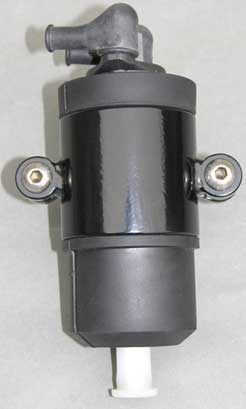
For things like fuel pumps, we have sorted through various suppliers looking for the best pumps for our applications. Some were smaller than others, which was a plus, but the quality varied and formed metal nipples or plastic casings could crack...and some had shitty push-on blade connectors that, while they worked, were questionable. Water proofing these tended to be a hassle.
Pumps have to be of very high quality and are typically rated for about 3,500 to 5,000 hours life...assuming you donít try to pump even microscopic grit through them...and if you donít run them dry. We sorted though many manufacturers and tend to use pumps that have a German accent...pumps which have weather seals on the connectors, screw-on terminals, banjo fittings, and a distinct lack molded plastic parts. We make sure you filter the gas before it gets to these expensive items.
Powder coated mounts, rubber isolated and stainless steel hardware. Different pumps for different horsepower ratings. The German pumps we use are static @ 400hp and 550hp....We like to see at least 30% bypass fuel at peak numbers so we use these pumps for applications up to 307.7 hp and 423hp respectively.
For larger applications, like Big Inch Pro Gas Turbos, we use larger pumps and regulators from SX Peformance.
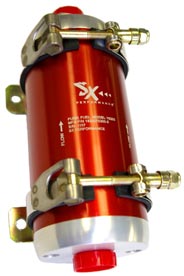
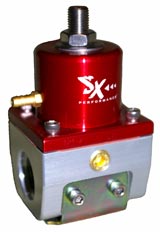
These allow the use of 600+ hp capable turbochargers and remove restrictions that would occur in regulators with less bypass area. It all gets expensive.
I want to program my ignition
Not with our RSR ECU because it does not control ignition timing. If you think fuel map programming is difficult just try to program your ignition curve. This presumes you know more than the factory, which is doubtful. It also presumes you have some way of evaluating your changes which is even more doubful. In cylinder pressure transducer equipment, sensors and software runs well into the $100,000.00 range and properly equipped dyno cells with climate control can cost a million dollars or more. It is best you go with stock timing and then venture off into the various aftermarket solutions if you just have to fiddle with it. We have seen nothing but trouble in this area and are sick and tired of people telling us they are going to kick their timing this way and that and they've never had a lick of training. Timing is a very tough business to play with and most people use it as a band-aid to cover poor engineering of other components...e.g. lots of boost, poor fuel control and no intercooler. You have a lot of things to worry about when you play engineer and this should be the last item on your list. Remember, proper scientific method is to alter one thing at a time and eliminate the variables. Adding ignition timing to the fray exponentially increases your problems. A modern Formula One V-10 runs about 50 degrees of spark lead...the question is... would you have known this in advance, or known the reason why. Think about it.
Records, records, records
RSR fuel injections, throttle bodies, and of course Autocal software have powered motorcycles to dozens of F.I.M. / SCTA and Bonneville speed records and remain we say with a great deal of pride the first efi systems to power stock engined motorcyles into the prestigious 200 mph clubs at Bonneville and El Mirage. A probably more impressive record is the over 1,000,000 miles of use with no electronic failures, a tough feat especially when you throw component destroying Harley Davidsons into the fray.
It's the mileage stupid
All this talk about records and speed overlooks an important aspect of the RSR system...it gets excellent fuel mileage, typically 45 to 55 mpg on most motorcycles, not a small consideration when it's a long way to the next gas stop and you are mentally calculating your point of no return. How about 44mpg on a ST1100 Honda going 110mph or an overall road average of 54 mpg on a 96 cubic inch S&S motor. As the lawyers say your mileage may vary, but with correct programming you can beat these figures.